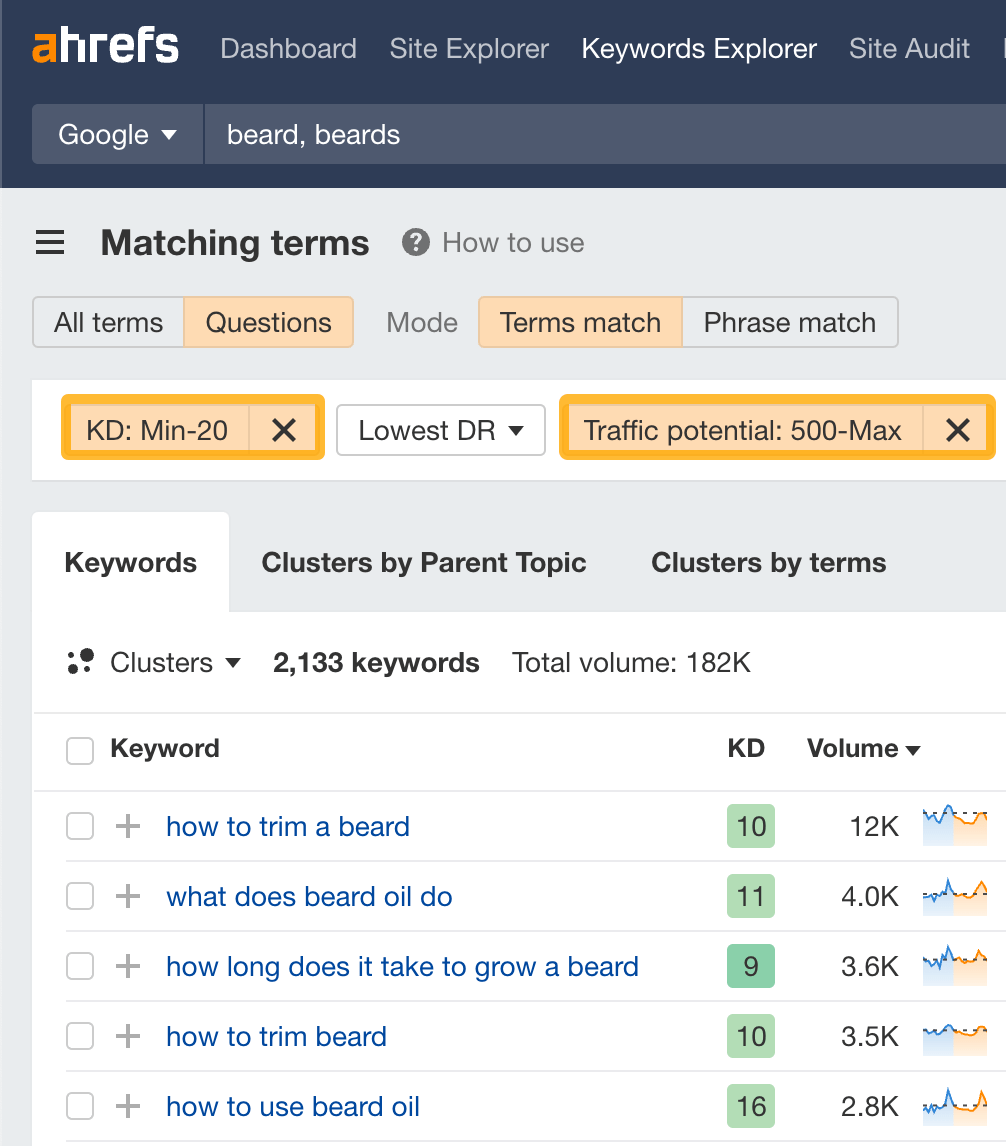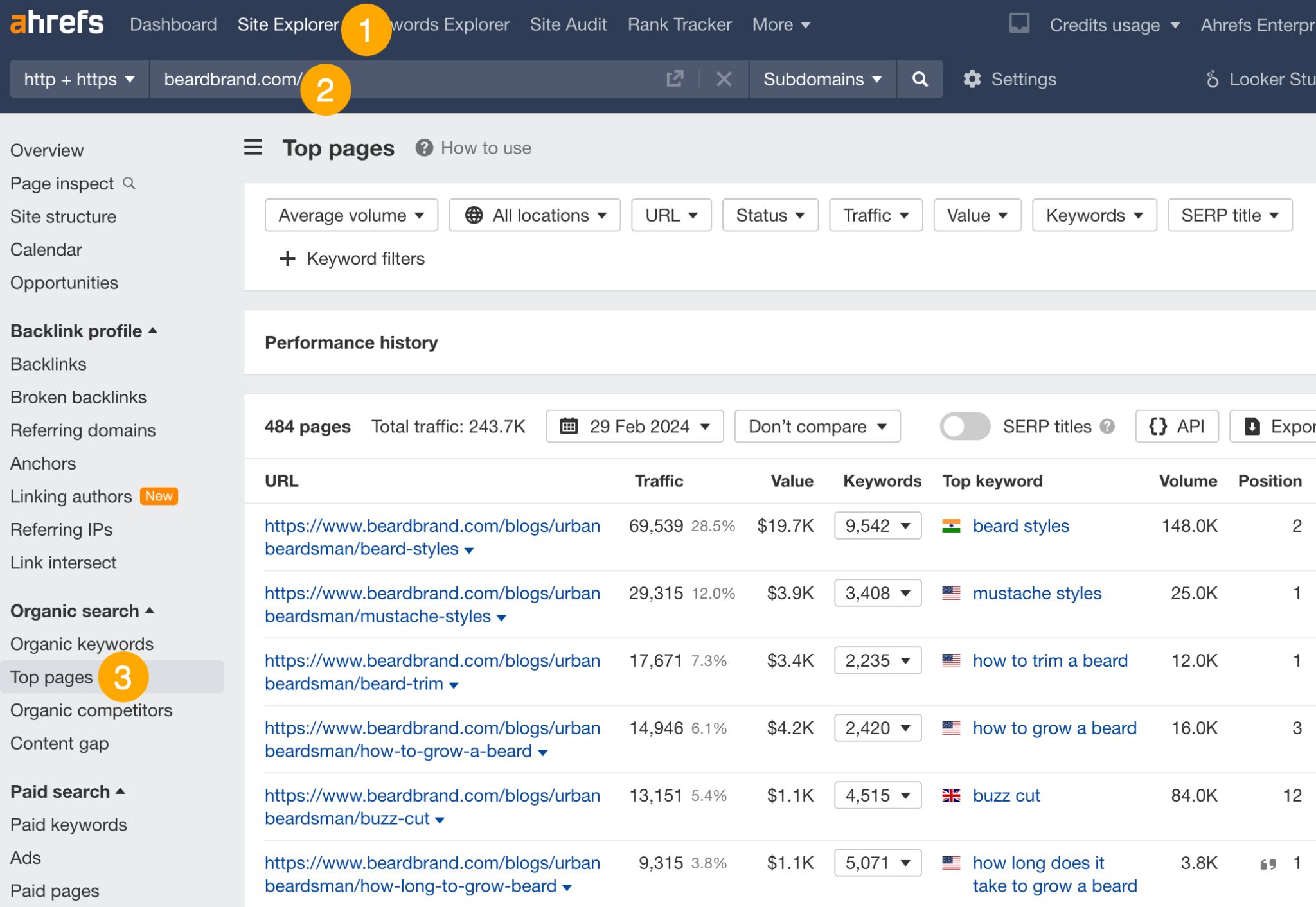SEO
100 Blog Post Ideas to Get Traffic

It’s easy to come up with blog post ideas, but writing about random topics won’t get you traffic to your blog.
You need to write about topics with traffic potential.
The proverb goes, “Give a man a fish, and you feed him for a day; teach a man to fish, and you feed him for a lifetime.”
If you know how to find blog post ideas on your own, you’ll always be able to find relevant topics with search traffic potential.
Here are two ways to do that:
1. Do keyword research
Keyword research is where you find the words and phrases your target audience is typing into Google. The easiest way to start is to use a keyword research tool like Ahrefs’ Keywords Explorer.
Just enter a relevant topic, go to the Matching terms report, switch the toggle to Questions, and you’ll get tens of thousands of potential keyword ideas:
If the list is too large, you can narrow it down using a Keyword Difficulty (KD) filter and a Traffic Potential (TP) filter to focus on high-traffic, low-competition keywords. Just set the max KD filter to a low number like 20 and the TP filter to a minimum of something like 500:


If you want to refine the list even further to keywords more likely to be within your wheelhouse, set the “Lowest DR” filter to your website’s Domain Rating (DR) score (find this by plugging your domain into Site Explorer). You will then see only keywords that websites of similar “authority” rank for.


2. Learn from your competitors
If you have competitors, they’re likely already ranking for many keywords on Google. You can see what they’re ranking for and target the same topics, too.
Here’s how:
- Go to Ahrefs’ Site Explorer
- Enter your competitor’s domain
- Go to Top pages


This report shows the pages generating the most search traffic for your competitor. For example, Beardbrand’s post on beard styles gets an estimated 69,000 monthly search visits. Out of the 9,542 keywords it ranks for, “beard styles” sends the most traffic.
If you’re competing with Beardbrand, this could be a good topic to write about.
Here are a few blog post ideas with traffic potential that we found using the methods above, broken down by category:
| Topic | Monthly Traffic Potential |
|---|---|
| How to create a business plan | 75,000 |
| How to do a SWOT analysis | 55,000 |
| What are key performance indicators | 13,000 |
| How to do a cost-benefit analysis | 8,400 |
| Types of marketing strategies | 6,800 |
| How to do business development | 5,700 |
| What is competitive advantage and how to find it | 5,000 |
| How to retain customers | 2,900 |
| How to acquire customers | 900 |
| How to manage a business’ cash flow | 700 |
| Topic | Monthly Traffic Potential |
|---|---|
| XX cheapest car insurance companies | 530,000 |
| XX best high yield savings accounts | 497,000 |
| How to make money online | 376,000 |
| How much house can I afford? | 264,000 |
| XX best travel credit cards | 149,000 |
| XX passive income ideas | 67,000 |
| How to improve credit score | 43,000 |
| How to invest in stocks | 43,000 |
| How to invest in real estate | 30,000 |
| XX ways to save money | 25,000 |
| Topic | Monthly Traffic Potential |
|---|---|
| What is content marketing and how to do it | 17,000 |
| How to do market research | 13,000 |
| How to create a marketing plan | 7,700 |
| What is lead generation and how to do it | 6,800 |
| XX top marketing trends | 3,800 |
| How to calculate and improve conversion rate | 3,600 |
| How to do customer segmentation | 2,200 |
| How to measure marketing ROI | 1,900 |
| XX types of marketing channels | 1,800 |
| What is a marketing funnel and how to build one | 1,800 |
| Topic | Monthly Traffic Potential |
|---|---|
| XX Taylor Swift concert outfit ideas | 51,000 |
| How to dress for your body type | 4,000 |
| Fashion weeks around the world | 2,800 |
| How to find your fashion style | 2,800 |
| XX cute outfit ideas | 2,600 |
| What is haute couture | 2,400 |
| XX airport outfit ideas | 2,300 |
| What is sustainable fashion and why it matters | 2,200 |
| XX fashion influencers to follow | 1,300 |
| What is slow fashion | 1,200 |
| Topic | Monthly Traffic Potential |
|---|---|
| How to get rid of acne scars | 37,000 |
| XX acne treatments that work | 28,000 |
| XX best moisturiser for dry skin | 9,600 |
| How to master the XX-step Korean skincare routine | 8,900 |
| How to prevent aging | 4,700 |
| XX natural beauty tips | 4,000 |
| What causes sensitive skin | 2,900 |
| XX best liquid eyeliner | 1,900 |
| XX beauty influencers to follow | 600 |
| XX best beauty supplements | 200 |
| Topic | Monthly Traffic Potential |
|---|---|
| How to use ChatGPT | 291,000 |
| XX best VPNs | 118,000 |
| XX best gaming laptops | 53,000 |
| XX best fitness watches | 37,000 |
| XX best budget gaming PCs | 20,000 |
| How to build a PC | 13,000 |
| How to make QR codes | 7,100 |
| The quietest mechanical keyboard | 2,600 |
| GPU price trends | 2,100 |
| Why does my GPU fan not spin and how to fix it | 1,400 |
| Topic | Monthly Traffic Potential |
|---|---|
| Intermittent fasting for beginners | 69,000 |
| XX kettlebell exercises for a full workout | 7,000 |
| XX best pull-up substitutes | 5,700 |
| Can you gain muscle in a calorie deficit | 4,700 |
| XX grip strength exercises | 4,000 |
| The best workout for skinny guys | 2,200 |
| How to do a pull up | 2,200 |
| A handstand progression plan | 1,100 |
| Are acai bowls good for weight loss | 700 |
| Jedi training | 300 |
| Topic | Monthly Traffic Potential |
|---|---|
| How to find cheap hotels | 195,000 |
| XX best travel blogs | 9,000 |
| Best places to visit in Costa Rica | 6,500 |
| XX things to do in Medellin | 3,300 |
| Is Cancun safe | 2,900 |
| XX best travel tips | 2,900 |
| How to travel cheap | 2,900 |
| Where to stay in Boston | 2,200 |
| Is Greece expensive | 1,100 |
| 5-day Paris itinerary | 800 |
| Topic | Monthly Traffic Potential |
|---|---|
| Where to buy inexpensive furniture | 18,000 |
| XX living room color ideas | 12,000 |
| XX accent wall ideas | 9,300 |
| How much does an interior designer cost | 4,000 |
| XX types of couches | 3,200 |
| XX bedroom essentials | 2,000 |
| How to decorate coffee table | 1,600 |
| Rules for rug under bed | 1,600 |
| How to measure for a sectional | 1,100 |
| XX best loveseats | 600 |
| Topic | Monthly Traffic Potential |
|---|---|
| XX easy ramen recipes | 81,000 |
| Fish taco recipe | 57,000 |
| XX best espresso machines | 38,000 |
| XX must-try Peruvian dishes | 12,000 |
| XX pressure cooker recipes | 11,000 |
| How to boil shrimp | 10,000 |
| How to keep apples from turning brown | 3,500 |
| XX Chinese New Year foods for good luck | 2,300 |
| Sous vide ribeye recipe | 1,500 |
| How to peel garlic | 350 |
Final thoughts
If you’re serious about blogging, you need to learn how to do keyword research and competitive research. Once you master that, you never have to worry about running out of blog post ideas again.










